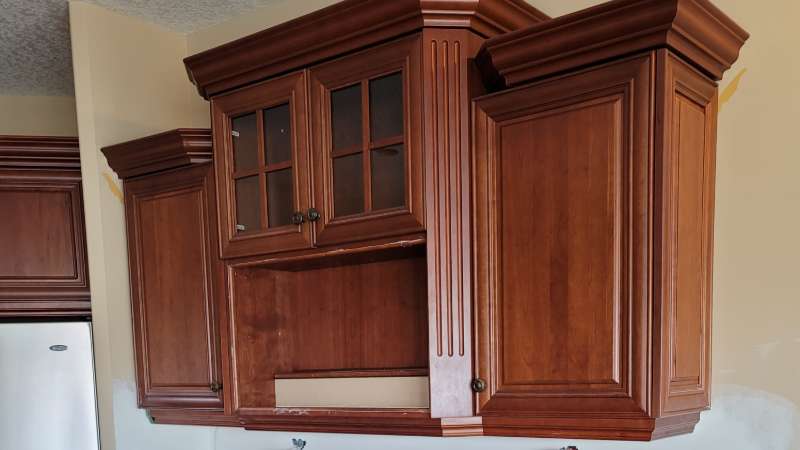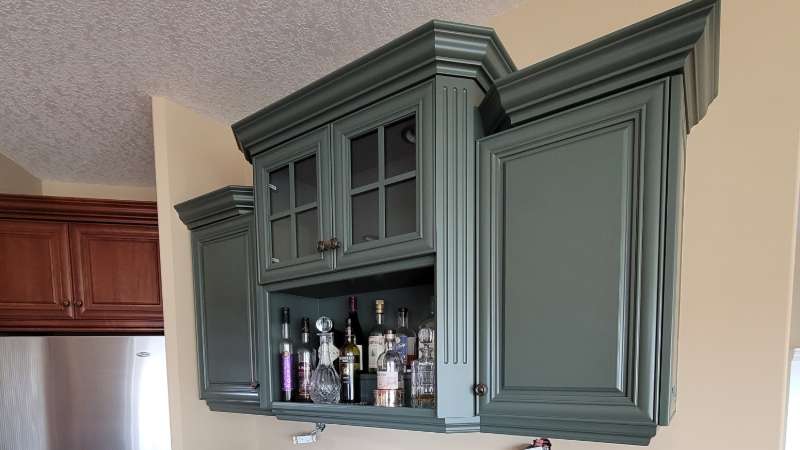Cabinet Painting Calgary, AB
Kitchen Cabinet Painting In Calgary
Are you looking for an affordable way to upgrade the appearance of your outdated kitchen cabinets? Painting your cabinets is a great way to get a brand new look in your space without the huge expense of replacing the cabinets. Instead, we can just clean them up, sand them, and repaint them in a new color .
Image Line Painting is a full service painting contractor based out of Calgary and serving the surrounding area. We specialize in painting cabinets in your kitchen, bathroom, laundry room, or any room in your home with storage cabinets. As a reputable operated small business you can count on our punctuality, professionalism, and ability to execute your interior painting project to the highest standard of quality. We can apply a new smooth finish to your cabinets that will resist chips, scratches, and stains and is easily maintained by simply wiping it clean with a damp cloth.
Before & After Photos Of Our Work
Slide The Images Side To Side To See The Results Of Our Work!
Calgary Cabinet Painting Services We Offer
- Kitchen cabinet repainting
- Bathroom cabinet repainting
- New wood cabinet staining
- Kitchen cupboard refinishing
Paint Finishes Choices We Offer:
- High gloss finishes
- Semi-gloss finishes
- Matte (no gloss) finishes
- Modern white
- Endless color choices
Every Cabinet Painting Calgary Project Includes:
- An expert color consultation.
- Removal/replacement of all hardware from the cabinets.
- We take your cabinet faces and drawers to our wood finishing shop where they can be prepped and painted in clean environment without making a mess in your home.
- Scraping and sand areas to be painted for a smooth surface.
- Apply caulking at seams where ever necessary for a nice clean finished job.
We Provide The Following Surface Preparation On Every Cabinet Refinishing Project:
- Thorough cleaning of the cabinet faces (drawers and doors) to be painted.
- Scrape and sand any loose or flaking paint or stain.
- We will repair any cracks, dents, or old nail holes.
Why Would You Repaint Your Cabinets?
Because it’s a great way to improve the appearance of your space without the high cost of replacement. Image Line Painting provides cabinet painting services in Calgary, AB and we can give your old, outdated cabinets a brand-new look that will make your space much more modern and enjoyable to spend time in. We can do this for a fraction of the cost of replacement.
We use very specific paint for our cabinet repainting projects that is smooth, durable, and easy to clean and maintain. We can refinish your cabinets into a modern white tone or any color or stain tint of your choice. Painting your cabinets will modernize your home interior and add years to the life of your cabinetry. We can even add new hardware such as handles, knobs and repair any broken or bent hinges so your cabinets don’t just look new, they actually feel new!
Painting Bathroom Cabinets In Calgary
Your bathroom cabinets or bathroom vanity can often take a back seat to the kitchen but they also see frequent use. The humidity in your bathroom can wreak havoc on the cabinets and the frequent use can often leave scratches, dent, or cracks that detract from the appearance. If your bathroom hasn’t been updated in years then you may also have a color scheme that is no longer appealing but instead tacky or dull.
Painting your bathroom cabinets is a quick way to refresh and modernize it’s appearance and protect the surfaces for many years. You’re bathroom will have a whole new amazing look after refinishing the cabinets.
Why Choose Image Line Painting As Your Calgary Cabinet Painters ?
When you choose Image Line Painting to repaint your cabinets you're partnering with a team of professionals cabinet painters in Calgary. As a reputable operated small business you can count on our integrity, communication, punctuality, and ability to lead our small team through the completion of your project.
We have a solid track record of happy and satisfied customers, many of them calling on us again and again for their painting needs and also referring us to their friends and family. It's through the quality of our work that our business continues to grow.
Owner (Cristian Farkas) is checking in on every project and takes great pride in the work that Image Line Painting completes in our customers homes. We care about your painting project and we want to make sure we do the best job we possibly can. We provide unbeatable value, we keep your home spotless, our pricing is fair, and the quality of our finished painting work is unmatched.
If you'd like to schedule an estimate to paint your cabinets then give us a call 403-613-1045 or fill out our online painting estimate request form and we'll get right back you.


